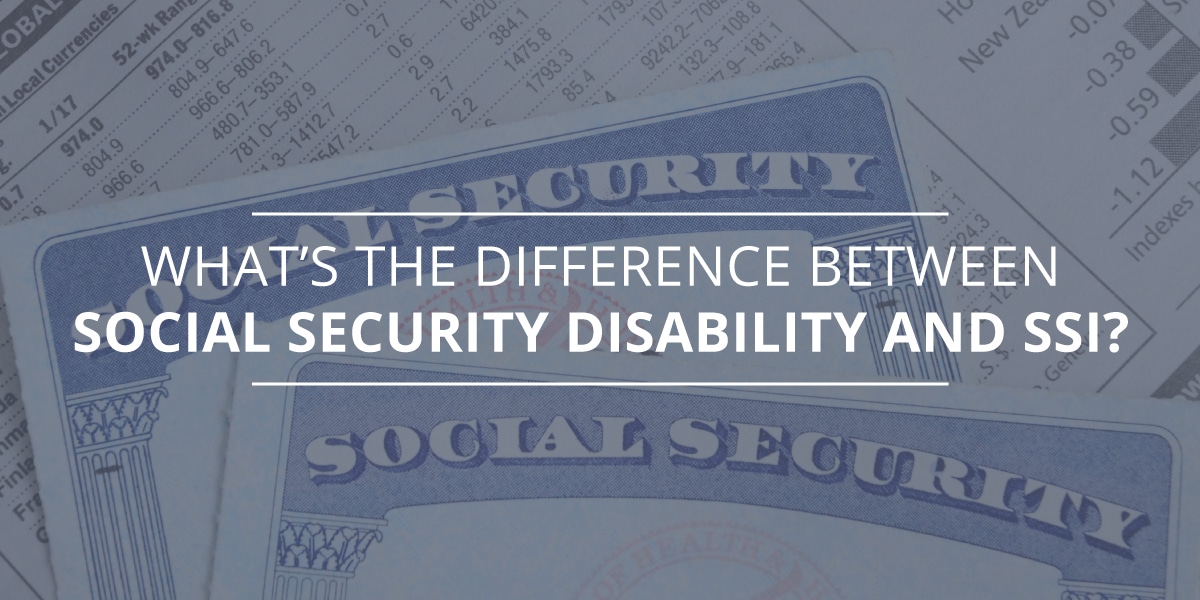
SSDI vs. SSI – When dealing with the federal government, it isn’t uncommon to hear a lot of acronyms. It can easily become confusing, especially when you are new to the system: SSA, SSI, ALJ, CDR, SSDI. What do they all mean and what is the difference between SSDI vs. SSI?
Difference Between Social Security Disability Income and Supplemental Security Income
Making sense of this alphabet soup is a necessary first step in deciding to file for benefits. The difference between the two programs (SSDI vs. SSI) administered by the Social Security Administration (SSA) are quite significant. Working with a disability benefits attorney can help you achieve the best possible outcome — from putting together a strong application through any hearing or appeal.
If you are considering filing for Social Security Disability Income (SSDI) or Supplemental Security Income (SSI) benefits, a disability lawyer can give you an edge. Read on to learn more about these two distinct types of benefits, and how you may qualify for SSDI vs. SSI, or both.
What Is Social Security Disability Insurance (SSDI)?
Social Security Disability Insurance (SSDI) is a disability benefits program administered by the SSA. To qualify, an individual must have worked in jobs covered by Social Security (i.e. paid enough into the Social Security system), and also must meet SSA’s definition of disability. Finally, an applicant must be unable to work for a year or more due to that disability.
The SSA examines an individual’s work credits to determine if they qualify for SSDI vs. SSI. A person must have worked long enough and recently enough to be eligible for benefits. A person can earn up to four (4) credits in a year towards Social Security work credits, and will need to have accumulated a certain number of credits to receive SSDI. Generally, once an individual is first insured, they need to have worked 20 quarters in the 40 quarters before they became disabled (some combination of 5 out of the last 10 years).
The definition of disability for purposes of SSDI benefits is different than for other programs. For purposes of SSDI, you are disabled if (1) you cannot do the work that you did before; (2) you cannot adjust to other work because of your medical condition(s); and (3) your disability has lasted or is expected to last for at least one year or to result in death.
A five-step sequential evaluation is used by the SSA to determine if an applicant is disabled. Each step of this evaluation requires an analysis of the applicant’s situation; depending on the conclusion, the individual will either be denied benefits, proceed to the next step, or be granted benefits. For example, the first question asks if a person is working, and if they earn more than $1,550/month (in 2024); if the answer is yes, then, with certain exceptions, the person will not receive SSDI benefits.
SSDI benefits are funded through payroll taxes. If approved, recipients receive monthly payments.
What Is Supplemental Security Income (SSI)?
Supplemental Security Income (SSI) is a needs-based program offered through the SSA. To be eligible, a person must be disabled, blind or aged 65 or older; blind or disabled children may also qualify. An individual must also have limited income and assets.
For people aged 18 and older, there are strict limits on the resources that you can own to be eligible for SSI. For individuals or children, you must have $2,000 or less in resources; for couples, the limit is $3,000. The SSI considers things you own to be resources, including cash, bank accounts, vehicles, and anything that you own that could be changed to cash. Exceptions are made for your primary residence, and one vehicle.
An individual also must have a limited income to be eligible for SSI. As of January 2024, the monthly income must not exceed $943 for an individual or child or $1,415 for a couple. This number is somewhat elastic, as the SSA does not count all types of income, but remains a low number for eligibility. Importantly, this does include your spouse’s income.
SSI is funded by the general fund of the U.S. Treasury, which comes from personal income, corporate and other taxes. Recipients of SSI can generally also receive medical assistance (Medicaid), and may be eligible for other benefits, such as food assistance.
SSI benefits are paid on the first of the month, on a monthly basis. Many — but not all — states offer supplemental benefits for SSI recipients to boost the amount provided by the federal government.
SSDI vs. SSI
Although both SSDI and SSI are administered through the SSA and pay monthly benefits, these programs have many important differences. Understanding how SSDI vs. SSI are different, and how these two programs work can help you make an informed decision about which is best for your specific situation.
Many people who are eligible for SSI benefits may also be entitled to SSDI benefits. The reverse may also be true for individuals whose SSDI benefits do not exceed the SSI income amount. SSI benefits are limited to individuals who are disabled, blind, or at least 65 years old and who have limited resources and assets.
Both benefits follow the same 5-step sequential evaluation process to determine whether you are disabled. However, unlike SSDI benefits, applicants for SSI do not have to prove that they worked a certain number of years or that they earned credits in order to be eligible. Instead, individuals simply need to demonstrate that they fit the criteria (blind, disabled or aged, plus limited income and assets) to qualify for SSI benefits. On the other hand, applicants for SSDI do not need to prove that their income (except from work) or assets fall below a certain threshold.
The medical standards for disability are generally the same for individuals aged 18 or older for SSI and SSDI. Both applicants for SSI and SSDI have to prove that they are unable to work due to their disability.
While children with disabilities are eligible for SSI benefits under different income standards, only adults can receive SSDI benefits. However, a dependent — such as a surviving spouse with a disability or a child (including an adult child with a disability) — may receive SSDI benefits in certain circumstances. Surviving spouses who are over 60 can qualify for benefits even if they do not have a disability.
How a Social Security Disability Lawyer Can Help
If you are suffering from a medical condition that has already limited or will limit your ability to work, you are likely overwhelmed by stress and anxiety. The thought of deciding whether you qualify for SSDI vs. SSI and handling your own application for SSDI or SSI benefits may be even more daunting. A seasoned disability lawyer can take on the burden for you, helping put together a strong application for benefits so that you can focus on your health and treatments.
For more than 20 years, the legal professionals of Bross & Frankel have worked throughout Pennsylvania and New Jersey, working to get our clients the benefits that they deserve. Our firm was founded by a former Social Security benefits authorizer, giving us a unique knowledge base when it comes to SSDI vs. SSI and beyond. To learn more or to schedule a free claim review, contact our office today at (856) 795-8880, or online.

Rich Frankel is the managing partner of Bross & Frankel. He is a member of the New Jersey and Pennsylvania bars. He has focused exclusively on disability and social security benefits since 2005.
Mr. Frankel joined what is now Bross & Frankel after having watched his father struggle with disability, fighting a lengthy illness. Mr. Frankel founded the firm’s veteran’s law practice and substantially grew the social security disability practice, focusing Bross & Frankel’s ability to fight for all of the disability benefits available to his clients.
Mr. Frankel additionally fights for clients in court, obtaining frequent victories in Social Security appeals and against insurance companies in Federal court.